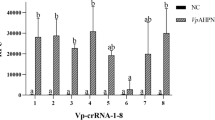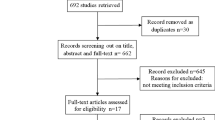Abstract
Classic approaches for antemortem identification of gastrointestinal nematodes (GIN) require coproculture of eggs and morphological examination. While adequate for diagnosis, many PCR techniques cannot easily quantify mixed infections without controls and/or standard curves. Herein, we developed a simple and rapid test for differentiating and quantifying mixed infections of GIN using PCR products separated by capillary electrophoresis. Among the cattle GIN, the ITS2 region is sufficiently distinct in length to delineate among the most common infecting genera, Ostertagia ostertagi = 373 bases (b), Haemonchus contortus (placei) = 366b, Cooperia punctata (oncophora) = 376b, Trichostrongylus axei = 372b, and Oesophagostomum radiatum = 357b. Conserved primers were synthesized that span the ITS2 where one primer was fluorescently labeled with 6-FAM. DNAs from infective L3 were PCR amplified then loaded onto an ABI 3130 sequencer adapted for size fragment analysis. Resulting peak amplitudes were both diagnostic and quantitative on a relative basis. As proof of principle, quantification was performed on PCR fragments from mixed species pairs of Ostertagia ostertagi, Cooperia punctata, and Haemonchus contortus and analyzed using Gene Marker V1.85 software. In all cases, linear responses were observed where R2 > 0.97 and line slopes ranged between 0.90 and 1.1. When tested on eggs from naturally infected animals, the assay showed superior results on two farms when compared to coproculture and morphological identification. Using wildlife-derived samples, results coincided well with deep amplicon sequencing. The assay is adaptable to large-scale studies, does not require comparative PCR controls, and should be compliant with GIN from small ruminant livestock.




Similar content being viewed by others
References
Akbari A, Marthinsen G, Lifjeld JT, Albregtsen F, Wennerberg L, Stenseth NC, Jakobsen KS (2008) Improved DNA fragment length estimation in capillary electrophoresis. Electrophoresis 29:1273–1285
Avramenko RW, Redman EM, Lewis R, Yazwinski TA, Wasmuth JD, Gilleard JS (2015) Exploring the gastrointestinal “nemabiome”: deep amplicon sequencing to quantify the species composition of parasitic nematode communities. PLoS ONE 10(12):e0143559. https://doi.org/10.1371/journal.pone.0143559
Brownstein MJ, Carpten JD, Smith JR (1996) Modulation of non-templated nucleotide addition by Taq DNA polymerase: primer modifications that facilitate genotyping. Biotechniques 20:1004–1010
Barone CD, Wit J, Hoberg EP, Gilleard JS, Zarlenga DS (2020) Wild ruminants as reservoirs of domestic livestock gastrointestinal nematodes. Vet Parasitol 279:109041. https://doi.org/10.1016/j.vetpar.2020.109041
Georgi JR, McCulloch CE (1989) Diagnostic morphometry: identification of helminth eggs by discriminant analysis of morphometric data. Proc Helminthol Soc Wash 56:44–57
Gasbarre LC, Ballweber LR, Stromberg BE, Dargatz DA, Rodriguez JM, Kopral CA, Zarlenga DS (2015) Effectiveness of current anthelmintic treatment programs on reducing fecal egg counts in United States cow-calf operations. Can J Vet Res 79:296–302
Herlich H (1976) Attempts to produce protection against Ostertagia ostertagi in cattle. Am J Vet Res 37:61–64
Magnuson VL, Ally DS, Nylund SJ, Karanjawala ZE, Rayman JB, Knapp JI, Lowe AL, Ghosh S, Collins FS (1996) Substrate nucleotide-determined non-templated addition of adenine by Taq DNA polymerase: implications for PCR-based genotyping and cloning. Biotechniques 21:700–709
Mansfield E, Vainer M, Enad S, Barker DL, Harris D, Rappaport E, Fortina P (1996) Sensitivity, reproducibility, and accuracy in short tandem repeat genotyping using capillary array electrophoresis. Genome Res 6:893–903
Monsion B, Duborjal H, Blanc S (2008) Quantitative single-letter sequencing: a method for simultaneously monitoring numerous known allelic variants in single DNA samples. BMC Genomics 9:85. https://doi.org/10.1186/1471-2164-9-85
Qazi F, Khalid A, Poddar A, Tetienne JP, Nadarajah A, Aburto-Medina A, Shahsavari E, Shukla R, Prawer S, Ball AS, Tomljenovic-Hanic S (2020) Real-time detection and identification of nematode eggs genus and species through optical imaging. Sci Rep 10(1):7219. https://doi.org/10.1038/s41598-020-63747-5
Roeber F, Kahn L (2014) The specific diagnosis of gastrointestinal nematode infections in livestock: larval culture technique, its limitations and alternative DNA-based approaches. Vet Parasitol 205:619–628
Rosenblum BB, Oaks BF, Menchen S, Johnson B (1997) Improved single-strand DNA sizing accuracy in capillary electrophoresis. Nucl Acids Res 25:3925–3929
Schumm JW (1997) Why use a size marker and allelic ladders in STR analysis? Promega Corporation Profiles in DNA 1:11–13
Seesao Y, Gay M, Merlin S, Viscogliosi E, Aliouat-Denis CM, Audebert C (2017) A review of methods for nematode identification. J Microbiol Methods 138:37–49
Sommer C (1996) Digital image analysis and identification of eggs from bovine parasitic nematodes. J Helminthol 70:143–151
Sommer C (1998) Quantitative characterization of texture used for identification of eggs of bovine parasitic nematodes. J Helminthol 72:179–182
Stromberg BE, Gasbarre LC, Ballweber LR, Dargatz DA, Rodriguez JM, Kopral CA, Zarlenga DS (2015) Prevalence of internal parasites in beef cows in the United States: results of the National Animal Health Monitoring System’s (NAHMS) beef study, 2007–2008. Can J Vet Res 79:290–295
Van Wyk JA, Cabaret J, Michael LM (2004) Morphological identification of nematode larvae of small ruminants and cattle simplified. Vet Parasitol 119:277–306
Yazwinski TA, Tucker CA (2006) A sampling of factors relative to the epidemiology of gastrointestinal nematode parasites of cattle in the United States. Vet Clin North Am Food Anim Pract 22:501–527
Zarlenga DS, Barry Chute M, Gasbarre LC, Boyd PC (2001) A multiplex PCR assay for differentiating economically important gastrointestinal nematodes of cattle. Vet Parasitol 97:199–209
Zhang XC, Gassmann W (2011) Quantifying alternatively spliced mRNA via capillary electrophoresis. Methods Mol Biol 712:69–77
Acknowledgements
We would like to recognize the prior work of Dr. John Gilleard and supporting lab members at the University of Calgary for foundational studies on nemabiome sequencing
Author information
Authors and Affiliations
Corresponding author
Ethics declarations
Conflict of interest
The research was funded under the auspices of Agricultural Research Service Project No. 8042-32000-105-00D. The authors have no relevant financial or non-financial interests to disclose. Experiments involving animals were performed under protocol no. 20-010 that was approved by the Institutional Animal Care and Use Committee.
Additional information
Handling Editor: Julia Walochnik
Publisher's note
Springer Nature remains neutral with regard to jurisdictional claims in published maps and institutional affiliations.
Supplementary Information
Below is the link to the electronic supplementary material.
436_2021_7340_MOESM1_ESM.pdf
Supplementary file1 Comparison of CE-FLA and nemabiome sequencing data from wildlife samples As additional proof of principle, CE-FLA was performed as described and compared to Nemabiome sequencing data from Barone et al. (2020) using wildlife samples. Results showed a high level of congruence among the two techniques. Minor peaks in CE-FLA migrating below 355b are not shown. Lanes highlighted in green present a high level of divergence between the two techniques that was not further investigated. Using the conditions and primers described herein, fragments migrating at or near 372b could not unequivocally be called by CE-FLA when O. ostertagi or O. gruehneri and Trichostrongylus spp. were present in the same sample; however, this occurrence is less probable in domestic livestock. (PDF 441 KB)
436_2021_7340_MOESM2_ESM.pdf
Supplementary file2 Alternative primer sets This table describes an alternative primer set (1687/1690) along with the appropriate call sizes of amplified fragments, that is capable of differentiating O. ostertagi and O. gruehneri from Trichostrongylus spp. The primer set is diagnostic but not quantitative. (PDF 503 KB)
Rights and permissions
About this article
Cite this article
Zarlenga, D., Barone, C., Hebert, D. et al. A simple molecular method to identify and quantify genera of gastrointestinal nematodes of cattle. Parasitol Res 120, 3979–3986 (2021). https://doi.org/10.1007/s00436-021-07340-3
Received:
Accepted:
Published:
Issue Date:
DOI: https://doi.org/10.1007/s00436-021-07340-3




